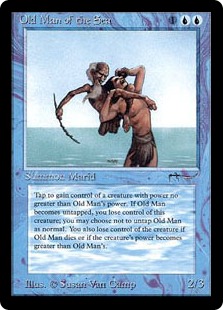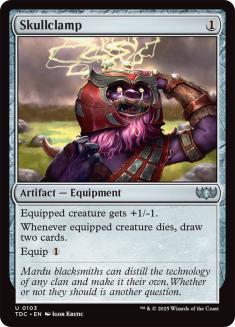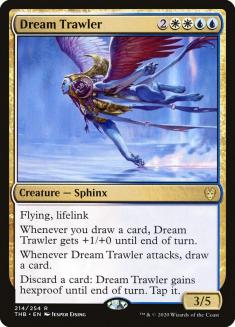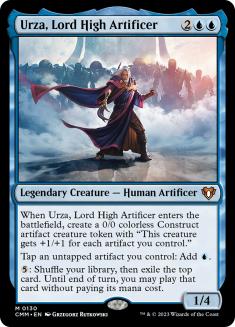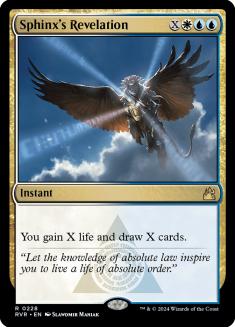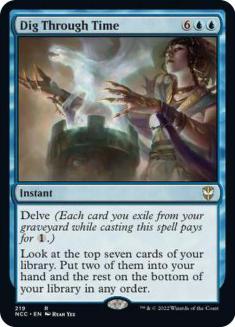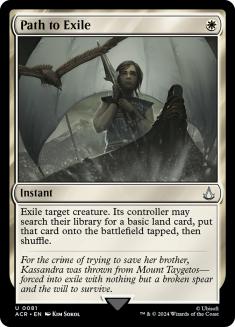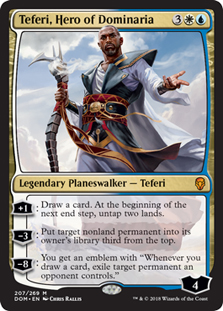Building a control deck is an art form. I have been a deckbuilder from the day I began slinging spells, testing the boundaries of formats with the power of combo and control. Many of you who have followed me for the last fifteen years have seen the intricate combo decks I have pieced together, using cards like Krark-Clan Ironworks, Greater Good, Mass Polymorph, Protean Hulk, and Momentary Blink. I have always kept my eyes open for ways to craft broken interactions to end the game early.
This draw to combo decks has been peppered into my career; however, my true love rests in creating an unwinnable game that lasts an eternity for my opponent, with the power of disruption and card advantage.
I know this may shock some of my readers, but the internet hasn’t always been around. Before the time of Google, competitive mages had to craft their tournament decks from thin air. There were some publications and Magic Online was in its infancy, but the data wasn’t there like it is today. Now, you can scroll to the bottom right of this website and check out the top lists from every live, competitive tournament in recent history. This, plus the database of digital high finishes, takes away some of the heartache us older folks used to suffer from when trying to find a starting point for an upcoming tournament. To add to all of that, strategy articles, especially the ones you find here, illuminate these competitive decks by telling their story and providing valuable insight that leads to readers winning matches.
This is not meant to be a “back in my day” lecture, but it’s important to see where I’m coming from with how I build my decks. Depending on the history of a deckbuilder, the way a good deck is built can wildly differ. Reading an article with a new decklist from one of the older pros will have the feel of something new, risky, and innovative, whereas a more recent pro tends to have products refined, safe, and perfectly designed for a weekend-specific metagame. Keep this trend in mind when reading content from around the world and see how it holds up. I am confident you will, if you haven’t already, see the differences in theory and deck creation from various content creators.
The old way to build decks has slightly changed with this explosion of information. Before, putting the most powerful control spells into a scrambled shell was a viable way to take down any tournament. My first success outside of my local game store was a 9-1-1 record at Mideast Regionals in 2003. For that tournament, I played a 26-land Selesnya Control deck with two Temple of the False God, some Birds of Paradise, Wrath of God, Decree of Justice, Akroma’s Vengeance, Skullclamp, and Ravenous Baloth.
This wasn’t the genius of deckbuilding, but a young fool playing all the control elements that he loved. In today’s competitive world, there are specific decks that must be beaten, the spells are weaker than creatures, and there must be a general order of things that create synergy in every list you play.
Step One: Identifying Strong Preview Cards
The first step I take when building a control deck is creating an Excel spreadsheet, with each format having its own unique tab at the bottom, to track cards that should see competitive play. I often must revise this list, adding cards that I missed and subtracting cards that turn out to be awful. This is the main reason I get excited during preview season, seeing which cards can help push control over the top in competitive play.
This list simply has the name of the card, color, and short description. Having that little bit of information is valuable for me when I need to sort and helps me expedite the deck creation process.
I haven’t always used an organized method like this; instead I scrolled through databases trying to find that perfect two-mana removal spell for a good twenty minutes. Card databases, like the one on StarCityGames.com, have been helpful when double-checking options that I may have overlooked. I used it to find Myr Retriever when crafting Ironworks and the rest is history.
Nonetheless, having a spreadsheet, or any type of organization like this, will have you brewing in the lab more frequently. I find myself regularly referring to it as I try to adapt to this fast-changing world and is the reason why I could add a card like Dawn of Hope to my Azorius Control deck to crush the mirror. Rogue cards like this are not always on our minds, nor do we have the time to constantly look through each blue and white card whenever we have a new threat that must be extinguished.
As preview cards are released, some are absolute slam dunks that spur deckbuilding immediately. Dream Trawler made Azorius Control automatically viable, even if the supporting cards in Standard were not up for the challenge. Luckily, this win condition was followed by Elspeth Conquers Death, leaving just the gaps to be filled in, and so cards like Glass Casket, Brazen Borrower, and Absorb enter the spotlight of a new age of control in the format. We all knew that Teferi, Time Raveler and Narset, Parter of Veils would rise to the challenge, but the rest of the deck is completed by referring to cards that have not seen play for quite some time (or ever before at all).
In Modern and Pioneer, this list doesn’t have every applicable card. I do a great deal of adding, but didn’t adopt this strategy until recently. Before, I would see a great preview card, hit the databases, and spend many hours with Notepad open, typing in each card that could serve a purpose in the deck in progress. Since you all are probably new to the organizational method as well, there’s nothing wrong with having a record on the side and doing it the old-fashioned way.
For Modern and Pioneer, seeing a strong preview card may not always spur a deck from scratch due to the size of the card pool. In Pioneer, the old Azorius Control elements are still strong enough to create the perfect shell, especially with mana being a giant barrier to a third color. This means your scope should be narrowed to the two colors at this point, looking for cards that can help push it over the edge. We have already seen that with Dream Trawler, and it’s a staple in Pioneer control decks already.
Modern has a giant card pool, but Modern Horizons changed the way preview cards spark deckbuilding. This set is responsible for some atrocious gameplay but may have saved control after the banning dust has settled. Urza, Lord High Artificer triggered an artifact search from me, and I’ve been building combo and control decks around it ever since. Keeping your eye on high-powered previews for Modern and Pioneer isn’t too difficult. The real challenge for deckbuilding during preview season is to identify cards that can take out threats to control’s viability.
Step Two: Mana, Hitting Land Drops, and Card Advantage
The second step of building a control deck is the most important and causes more failure than any other. Control decks tend to stretch out the mana capabilities more than the competition, making some variations dead on arrival. Esper Control in Pioneer is a great example of this. I had an extremely high win rate with it for a few months, but the mana eventually caught up to me. Even though the other boxes were checked, the requirements of double white, double black, and double blue were nearly impossible to guarantee each game without the help of fetchlands. This can be mitigated with early cantrips that provide more looks and a high land count, but stumbling nearly locks in a loss in the competitive world.
Hitting land drops is arguably the tallest hurdle to leap when considering card choices in a new control deck. The Birth of Meletis is one of the greatest arrivals for control in recent history and I missed its beauty when it was first previewed. It’s a guaranteed land drop with additional upside on Turn 2.
When cards like this aren’t an option or we’re looking at an older format, cantrips and scry/surveil can be used. Thought Erasure carried the hitting land drop torch for a long time in Standard and currently does in Pioneer. Simply having that option to ditch the top card of the library is a lifeline for control decks more than any other. Cantrips with that capability attached are even better for the cause, making Omen of the Sea another hot commodity in the current Standard.
This type of addition is often overlooked, or blindly copied without knowing why. Having a Turn 1 or Turn 2 way to increase the chances of hitting lands three and four is more important than card advantage, removal, or any win condition.
Card advantage is an obvious strength of control decks. When people see that phrase, they think Sphinx’s Revelation, Dig Through Time, and other broken tools of the past that filled the hand with the perfect cards. In the competitive formats today, however, I have completely changed my philosophy on what card advantage should look like. If we’re hitting land drops, the card advantage should come from static sources like sweepers, planeswalkers, and win conditions.
This doesn’t mean I’ll leave Dig Through Time on the bench while it’s around, but anything short of a card in that category that should be banned will likely not be in my decks. Planeswalkers and creatures are too good these days and there is no reason to play watered-down spells of the past over them.
Step Three: Disruption and Win Condition
The last step determines how powerful the control deck is in the format, depending on the metagame. Steps One and Two provide the glue that holds the foundation together, allowing Step Three to take place. Without the knowledge of options, manabase, consistency in land drops, and card advantage, it doesn’t matter how good the disruption and win condition are. Luckily for all three formats, we have the foundation to create great things and that is evident in tournament results from around the world.
Disruption varies dramatically in each format but choosing which to use is simple. In Modern and Pioneer, Thoughtseize and Fatal Push are staples in every black-based control deck. If you’re in the market for sweepers, Supreme Verdict is the gold standard for both of those formats as well. Every control deck I create has a full set of the best single-target removal spell, as well as three or four of the best sweepers when applicable.
For example, Azorius Control in Modern starts off with four Path to Exile and three Supreme Verdict, to defend against enemy creatures. In Standard, I am playing four Shatter the Sky, but only two Glass Casket. The reason is Glass Casket is not a great card in the format, where Shatter the Sky is amazing. Playing with a number of removal spells is key when building a control deck in any of the competitive formats and dictates which win condition you’re building around.
My control decks always have a win true win condition. You’ll never catch me decking my opponent with one copy of Elixir of Immortality, but you may see me prompt a concession from an opponent with Teferi, Hero of Dominaria. This is where planeswalkers come into the deckbuilding process. Planeswalkers are the best thing control has going for itself right now. Some may not have a win condition attached, but they provide the constant threat of card advantage, removal, powerful static abilities, and/or back-breaking ultimates that allow the win condition (when needed) to clean up. Sometimes I build around my win conditions (like Urza, Lord High Artificer), but often they are just the most powerful option available (like Dream Trawler).
Regardless of what you select as your champion, these steps provide a roadmap to a successful control experience. Using Step One to flesh out Steps Two and Three will save you mental energy and provide a final product you will be proud of.


